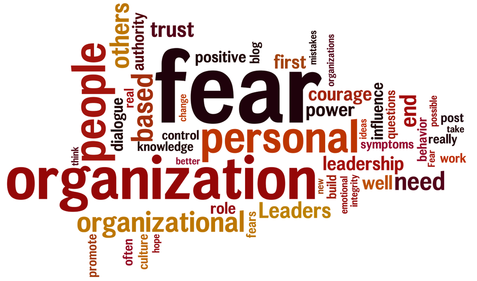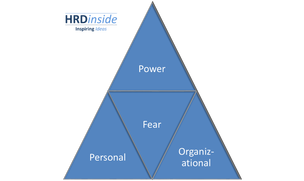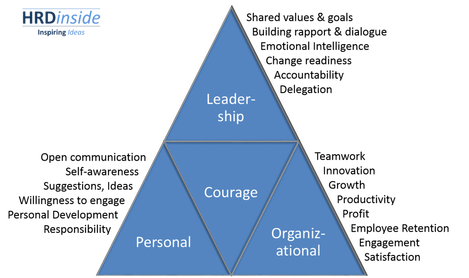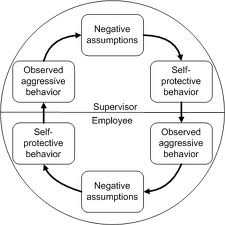Eradicate fear from your organisation
Do you sometimes experience hesitation, maybe even fear, to express your opinion? Is this because one of your superiors took part of the discussion? Or do you have little trust in the people taking part of the discussion, as you doubt their integrity? This could be based on little self-confidence or some negative experiences in the past. However, in most cases these are symptoms of an organizational culture based on fear. I had one of these experiences this week, which really made me think of my personal influence and courage to speak up, to ensure the fear factor in my organization would be minimized. In this blog post I share my analysis and conclusions and hope it will somehow help you!
In my search for more knowledge on the subject I found an article, published by Business Week in 2010 in which they introduce this definition of organizational fear:
In my search for more knowledge on the subject I found an article, published by Business Week in 2010 in which they introduce this definition of organizational fear:
“The principal signs of a fear-soaked senior leadership are a preoccupation with looking out for No. 1, a clampdown on consensus-building conversations, and the shunning or ousting of anyone so bold or naive as to tell the truth about what he or she believes. We've seen the fear epidemic hit dozens of major firms over the past few years, and it isn't pretty. When a leadership team's attention turns from "How can we do the right thing for our customers and employees?" to "How can we keep our stature, our jobs, and the status quo intact, at any cost?" then fear officially rules the roost”.

This blog post is also my analysis of a situation I experienced this week, as well as a more generic approach to find possible solutions. I concluded:
“Fear is not that obvious at first sight. In fact, fear has cloaked itself into various phenomena’s and is now a multi-layered problem in many organizations.”
Where does our focus need to be to minimize fear factors in the organization?
Or at least, how to influence and promote courage to come into the organization?
“Fear is not that obvious at first sight. In fact, fear has cloaked itself into various phenomena’s and is now a multi-layered problem in many organizations.”
Where does our focus need to be to minimize fear factors in the organization?
Or at least, how to influence and promote courage to come into the organization?
Summary

Fear in the organization is extremely unhealthy as it destroys growth, learning, retention, competency & (tacit) knowledge, and in the end the financial results of the organization.
Leaders should build rapport and dialogue, improve their effort to listen to people and understand their needs and concerns.
In the end it will have to come down to establishing a shared set of values and goals, as well as being prepared and ready for change, not just for the organization, but especially personal change.
Letting go of control is another element for leaders, which will allow people in the organization to take their responsibilities, show their capabilities, resulting in management trust and confidence. This will create the positive atmosphere which will motivate people to develop, grow and stand-up for striving for even better results.
The roles of individuals, teams and leaders are strongly connected. If it is based on courage, the impossible is possible. Therefore we have to start working on creating organizational courage, overcoming our personal fears, acquire the competencies needed to build trust and be aware of our role, our behavior and the way we communicate.
Leaders should build rapport and dialogue, improve their effort to listen to people and understand their needs and concerns.
In the end it will have to come down to establishing a shared set of values and goals, as well as being prepared and ready for change, not just for the organization, but especially personal change.
Letting go of control is another element for leaders, which will allow people in the organization to take their responsibilities, show their capabilities, resulting in management trust and confidence. This will create the positive atmosphere which will motivate people to develop, grow and stand-up for striving for even better results.
The roles of individuals, teams and leaders are strongly connected. If it is based on courage, the impossible is possible. Therefore we have to start working on creating organizational courage, overcoming our personal fears, acquire the competencies needed to build trust and be aware of our role, our behavior and the way we communicate.
Analysis
We first need to better understand the various aspects of fear in organizations, how this reflects on individuals and departments, and what kind of remedies are suggested. Let’s first focus on organizational symptoms of fear. I came up with the following list:
- Micro-management, simple decisions not allowed to be taken at appropriate levels in the organization.
- Time measurement instead of measuring output, people being hesitating to leave when the boss still is at work
- A unhealthy competitive atmosphere, up-to the level of stealing ideas from each other
- People’s first response is based on distrust, they always consider potential impact first
- Resistance to new ideas, as well as a lack of new ideas being put forward
- Performance numbers rule how people are being judged
- Often a “us” verses “them” culture
- Most discussions take place outside of the meeting room
- Political behavior is seen at all layers of the organization
- Performance and quality can only be gained through direct supervision
- Reluctant to admit mistakes, hiding mistakes, lying about mistakes
- Playing down or complete denial on issues brought forward

I recognized several symptoms but also realized my observations might only be my personal reality. Therefore I considered using a questionnaire to objectivize my conclusions. I found a simple example of a questionnaire on internet here: University of Cleveland - Australia.
I also wondered how organizational fear is related to personal behavior. In the end organizations are made up by people who, together, create symptoms as above.
The list below are examples of “expression” of fear, and at the same time could be a cause for instilling fear:
I also wondered how organizational fear is related to personal behavior. In the end organizations are made up by people who, together, create symptoms as above.
The list below are examples of “expression” of fear, and at the same time could be a cause for instilling fear:
- Interpersonal cold and abrupt behavior
- Ignoring suggestions, or delaying a response to them
- Emotional outbursts
- Important information not being shared appropriately
- Aggressive (body) language
- Inflexible communication style (not adapted to receivers)
- Failure to give others credit
- The dogma of “Knowledge is power” rules
- Minimizing diversity points of views
|
Employees, supervisors and managers experience all fear in a fear-based organization. Each group sees the other as having a great deal of power to control outcomes. They all think this may affect people within the other group profoundly. Employees and managers fear similar things, all having to do with loss. They fear the loss of:
|
Remedies
First off all, let’s focus on the “power” component of fear. We need to understand that intrapersonal and interpersonal fundamentals are keys to personal, professional and institutional success? Often power struggles counter genuine productivity and cause real and unnecessary suffering in the process. Power has also to do with authority. First of all, authority can be based on position in the organization, this concerns the authority given to you.
Next to this, and this is the real meaning of the word authority, it can be based on expertise knowledge. The word authority is derived from the Latin word “auctoritas”, meaning invention, advice, opinion, influence, or command. The last element of power is influence. Some people have more influence than others, independent of their position and sometimes also not always related to their “level of expertise”. This is about personality based power, which is an interesting setting. It can turn out negatively as well as positively.
In the end, it is about leadership. I think it is better to leave this subject with the words of Edward Abbey: “few men are wise enough to rule themselves, even fewer ones are wise enough to rule others.” Power is not influenced easily, other than through leadership.
Self-awareness is the main topic when discussing personal fears. Awareness and honest self-reflection can act as an antidote to engaging in fear-based behaviors. Assumptions also often form the basis of personal fear, as they can be exaggerated or distorted, as well as conscious and unconscious. Personal fear will be fueled by questioning intentions, integrity, judgment and competency of others.
Organizational fear is to some extend based on personal fears as people are the organization. But it would be too simple to just work on the personal development of each individual. Leaders need to step up and take responsibility by starting to acknowledge their responsibility for creating and often participating in a fear-driven organizational culture. This can be done by reviewing their assumptions and related behaviors which trigger fearful responses in others. Leaders should consciously choose to communicate positively in a pro-active manner. Through this, they can break the cycle of fear and the consequential responses in the organization.
Leaders should engage in more open, collaborative conversations and promote positive participation of people. Leaders can do this by employing basic facilitation skills:
Jan Austin wrote an article on this in far greater detail. I suggest you read this here and find more on how to do this.
Next to basic facilitation skills, some other elements need to be looked at. Louise Altman wrote a blog post I really appreciated, as it makes very practical suggestions, and still taps in to the leadership area. Read “8 Ways to Decrease Organizational Fear” here.
Next to this, and this is the real meaning of the word authority, it can be based on expertise knowledge. The word authority is derived from the Latin word “auctoritas”, meaning invention, advice, opinion, influence, or command. The last element of power is influence. Some people have more influence than others, independent of their position and sometimes also not always related to their “level of expertise”. This is about personality based power, which is an interesting setting. It can turn out negatively as well as positively.
In the end, it is about leadership. I think it is better to leave this subject with the words of Edward Abbey: “few men are wise enough to rule themselves, even fewer ones are wise enough to rule others.” Power is not influenced easily, other than through leadership.
Self-awareness is the main topic when discussing personal fears. Awareness and honest self-reflection can act as an antidote to engaging in fear-based behaviors. Assumptions also often form the basis of personal fear, as they can be exaggerated or distorted, as well as conscious and unconscious. Personal fear will be fueled by questioning intentions, integrity, judgment and competency of others.
Organizational fear is to some extend based on personal fears as people are the organization. But it would be too simple to just work on the personal development of each individual. Leaders need to step up and take responsibility by starting to acknowledge their responsibility for creating and often participating in a fear-driven organizational culture. This can be done by reviewing their assumptions and related behaviors which trigger fearful responses in others. Leaders should consciously choose to communicate positively in a pro-active manner. Through this, they can break the cycle of fear and the consequential responses in the organization.
Leaders should engage in more open, collaborative conversations and promote positive participation of people. Leaders can do this by employing basic facilitation skills:
- Build connecting relationships: Leaders should establish rapport with people in the organization. Building these connecting relationships is essential to eliminate fear. This also supports positive communication, growth and change.
- Listen: Leaders often do the majority of the talking in their interactions with employees. Consciously choosing to shift from the “speak” mode to the “listen” mode can have a powerful positive effect on fear.
- Ask Questions which increase trust: Asking questions, which increase trust and reduce fear, can eliminate fear and increase trust levels by committing to a process of mutual discovery of possibility and potential. To do so means learning to ask great questions of others. Great questions always elevate and never diminish others.
- Promoting dialogue: In a dialogue, people give and receive without attachment or personal agenda. It results in an outcome not possible without the participation of everyone in the group. When dialogue is present, fear is absent. Leaders who are committed to dialogue can create a significant organizational cultural shift from fear to positive engagement.
Jan Austin wrote an article on this in far greater detail. I suggest you read this here and find more on how to do this.
Next to basic facilitation skills, some other elements need to be looked at. Louise Altman wrote a blog post I really appreciated, as it makes very practical suggestions, and still taps in to the leadership area. Read “8 Ways to Decrease Organizational Fear” here.
Conclusions

Fear in the organization is extremely unhealthy as it destroys growth, learning, retention, competency & (tacit) knowledge, and in the end the financial results of the organization.
The starting point is the organizational culture and how this can be influenced. In my view the leadership questions should be answered first.
This really starts with the personal vision of leaders on their role in the organization. The way they build rapport and dialogue, their effort to listen to people and understand their needs and concerns. In the picture this is represented by the emotional intelligence (EQ).
In the end it will have to come down to establishing a shared set of values and goals, as well as being prepared and ready for change, not just for the organization, but especially personal change.
Letting go of control is another element for leaders, which will allow people in the organization to take their responsibilities, show their capabilities, resulting in management trust and confidence. This will create the positive atmosphere which will motivate people to develop, grow and stand-up for striving for even better results.
The roles of individuals, teams and leaders are strongly connected. If it is based on courage, the impossible is possible. Therefore we have to start working on creating organizational courage, overcoming our personal fears, acquire the competencies needed to build trust and be aware of our role, our behavior and the way we communicate.
The starting point is the organizational culture and how this can be influenced. In my view the leadership questions should be answered first.
This really starts with the personal vision of leaders on their role in the organization. The way they build rapport and dialogue, their effort to listen to people and understand their needs and concerns. In the picture this is represented by the emotional intelligence (EQ).
In the end it will have to come down to establishing a shared set of values and goals, as well as being prepared and ready for change, not just for the organization, but especially personal change.
Letting go of control is another element for leaders, which will allow people in the organization to take their responsibilities, show their capabilities, resulting in management trust and confidence. This will create the positive atmosphere which will motivate people to develop, grow and stand-up for striving for even better results.
The roles of individuals, teams and leaders are strongly connected. If it is based on courage, the impossible is possible. Therefore we have to start working on creating organizational courage, overcoming our personal fears, acquire the competencies needed to build trust and be aware of our role, our behavior and the way we communicate.
My personal next steps
First of all I have to overcome some of my personal fears. One of them is based on the fear for exclusion. I will work on increasing my self-awareness and learn, practice and promote emotional intelligence. There is simply no excuse to dismiss the value of emotional literacy and competency. Inspiring and influencing others through passion, enthusiasm and courage is my true call.
I have to end my aversion for conflict. Too often I am afraid to have the critical conversations I need to make real progress. Most of my feelings that keep conflicts alive are the result of being fearful of honest confrontation. I have to wonder if a lack of skills plays a role in my conflict aversion and if fear is the glue that holds it together (thanks Louise Altman!).
In my management team role, I have to promote we delegate more of the responsibilities that can be taken up elsewhere in the organization. The need for control should be put into a new perspective. This also includes trying to control information, resources and decision making. This relates of course to the points above. Regardless of our position within our organization, we all have the opportunity to share our knowledge. This will be one of the fundamental keys to build trust
Honesty, reliability and integrity are in such short supply that many of us have become cynical about the possibilities of real transparency in the workplace. The reality is we cannot sustainably accomplish what we need to accomplish without it, eliminating the domination of fear.
In the end, this is about true empowerment, build on well informed and educated people. But it starts with inspiration.
I truly hope you get inspired by reading this. The writing of this blog post really inspired me to come up with an action plan for the organization I work in.
I hope to be able to report in its progress over time.
Your views and comments are welcome! Please share.
I have to end my aversion for conflict. Too often I am afraid to have the critical conversations I need to make real progress. Most of my feelings that keep conflicts alive are the result of being fearful of honest confrontation. I have to wonder if a lack of skills plays a role in my conflict aversion and if fear is the glue that holds it together (thanks Louise Altman!).
In my management team role, I have to promote we delegate more of the responsibilities that can be taken up elsewhere in the organization. The need for control should be put into a new perspective. This also includes trying to control information, resources and decision making. This relates of course to the points above. Regardless of our position within our organization, we all have the opportunity to share our knowledge. This will be one of the fundamental keys to build trust
Honesty, reliability and integrity are in such short supply that many of us have become cynical about the possibilities of real transparency in the workplace. The reality is we cannot sustainably accomplish what we need to accomplish without it, eliminating the domination of fear.
In the end, this is about true empowerment, build on well informed and educated people. But it starts with inspiration.
I truly hope you get inspired by reading this. The writing of this blog post really inspired me to come up with an action plan for the organization I work in.
I hope to be able to report in its progress over time.
Your views and comments are welcome! Please share.

